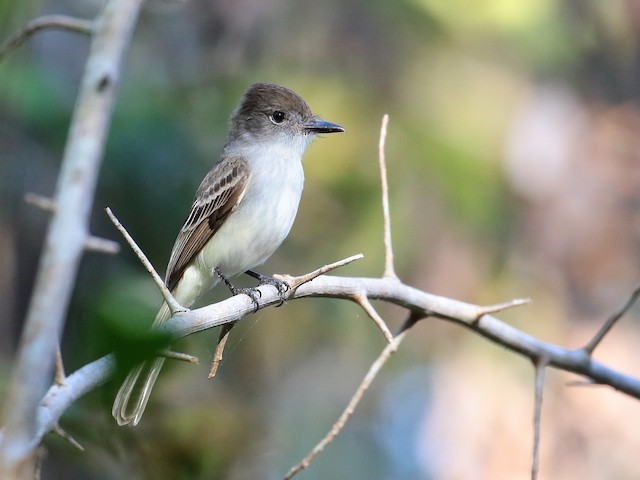Birdfinding.info ⇒ Generally common across most of its range. Occurs at all, or nearly all, of the sites frequented by visiting birdwatchers on Cuba, Grand Cayman, Grand Bahama, Abaco, and Andros. Usually easy to find when calling, but otherwise can be inconspicuous. In southern Florida, most often found on Key Biscayne at Bill Baggs Cape Florida State Park, where it has been roughly annual over multi-year periods. Other nodes of repeated occurrence include Boca Raton and Upper Key Largo.
La Sagra’s Flycatcher
Myiarchus sagrae
Family: Tyrannidae
Endemic to Cuba, its satellite islands, the Bahamas, and Grand Cayman, where it occupies various types of woodlands, including pine forest, dry forest, tall scrub, and mangroves.
In the Bahamas, occurs mainly in the north: Grand Bahama, Abaco, Andros, New Providence, Eleuthra, and adjacent smaller islands. Also found in the far south on Great Inagua, but occurs only locally or sporadically in between.
Movements. Mostly resident, but Bahaman populations are dispersive and regularly stray to southern Florida, primarily along the coast from Palm Beach to Key Largo between December and May.
Identification
A mid-sized Myiarchus with an ashy-gray throat, pale yellowish or whitish belly, three well-defined wingbars, bold whitish margins on the tertials and secondaries, and narrow rufous edging on the primaries. Often appears large-billed and bull-headed.

La Sagra’s Flycatcher, M. s. sagrae, showing typically bold whitish edgings on tertials. (Playa Ancón, Trinidad, Sancti Spíritus, Cuba; December 22, 2013.) © Guy Poisson
The Cuban race, sagrae, typically shows cold plumage coloration overall and usually lacks rufous tones in the tail.
The Bahama race, lucaysiensis, is typically warmer brown above, especially on the crown, with more yellow on the belly, and sometimes shows rufous tones on the underside of the tail.
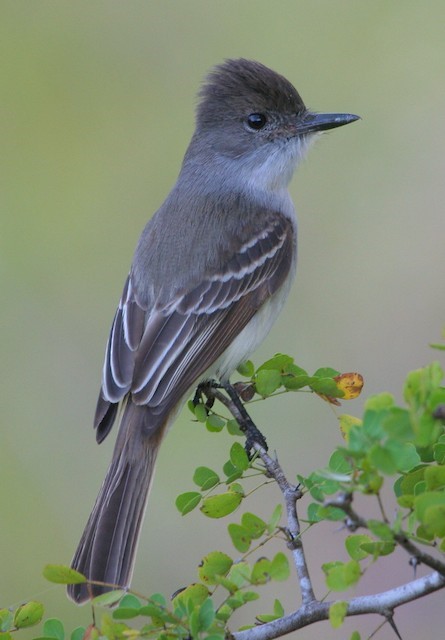
La Sagra’s Flycatcher, M. s. sagrae, showing three clear wingbars. (North Side, Grand Cayman; February 25, 2009.) © Jim Hoover
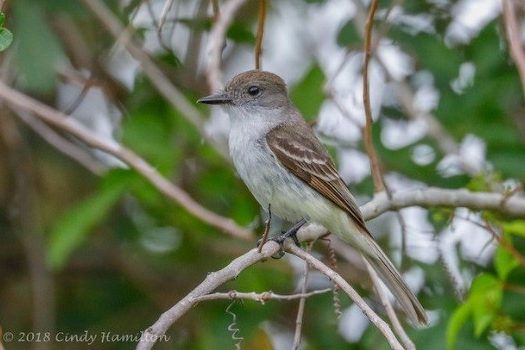
La Sagra’s Flycatcher, M. s. lucaysiensis, showing the comparatively warm brown coloration and yellowish belly considered typical of the Bahama race. (North Abaco, Bahamas; April 23, 2018.) © Cindy Hamilton

La Sagra’s Flycatcher, M. s. lucaysiensis, with uppermost wingbar mostly obscured. (Garden of the Groves, Grand Bahama; September 22, 2017.) © Erika Gates
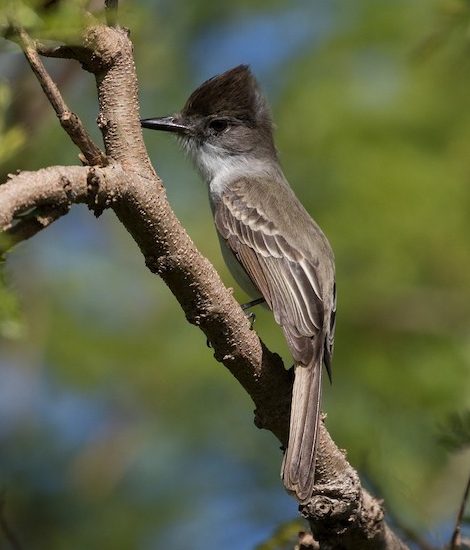
La Sagra’s Flycatcher, M. s. sagrae, crest raised for an emphatically bull-headed appearance, with atypically low contrast on wings. (Playa Pesquero, Holguín, Cuba; February 16, 2018.) © Suzanne Labbé
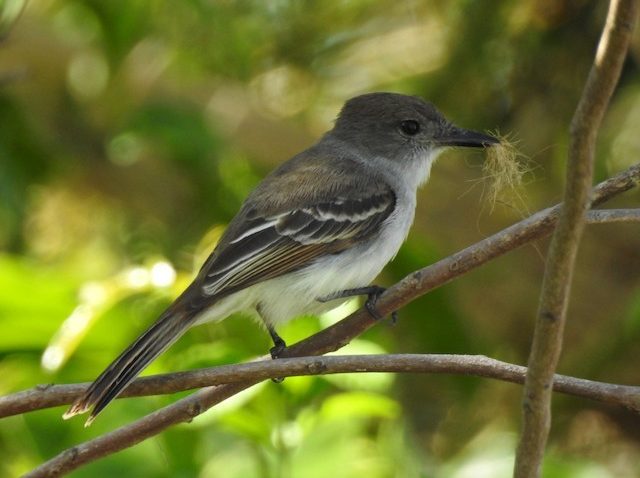
La Sagra’s Flycatcher, M. s. lucaysiensis, with generally cold plumage—more typical of sagrae. (The Emerald Golf Course, Grand Bahama; March 30, 2017.) © Erika Gates
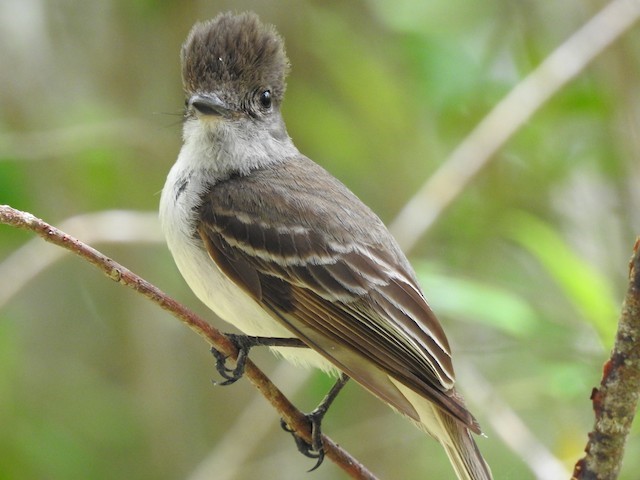
La Sagra’s Flycatcher, M. s. sagrae, crest raised, with generally warm plumage—more typical of lucaysiensis. (Queen Elizabeth II Botanic Park, Grand Cayman; May 21, 2017.) © Dany Garcia
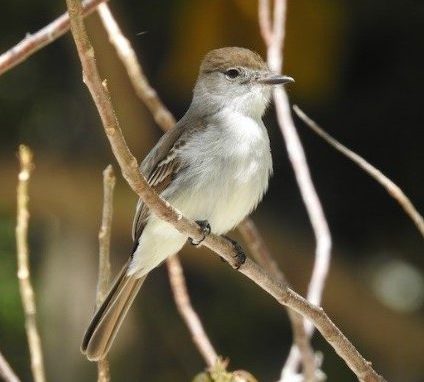
La Sagra’s Flycatcher, M. s. lucaysiensis, showing unusually warm-brown crown and rufous tones in undertail. (Garden of the Groves, Grand Bahama; April 2, 2018.) © C. Magnier

La Sagra’s Flycatcher, M. s. lucaysiensis, crest raised, and showing a typically faint yellowish tinge on the belly. (Garden of the Groves, Grand Bahama; April 9, 2018.) © Erika Gates
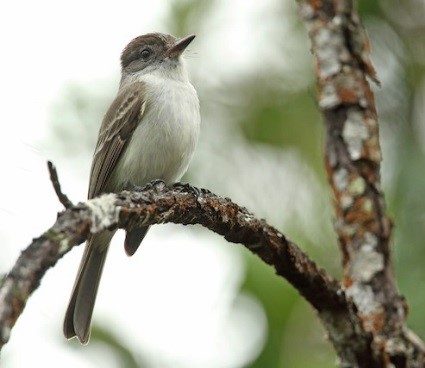
La Sagra’s Flycatcher, M. s. sagrae, showing cold-brown upperparts and whitish belly. (Cupeycillo Trail, Alejandro de Humboldt National Park, Cuba; January 27, 2016.) © Martjan Lammertink
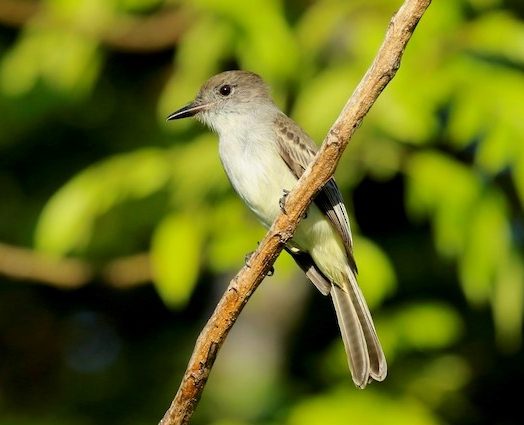
La Sagra’s Flycatcher, M. s. sagrae, showing a maximally yellowish belly and vent. (Cueva de los Peces, Matanzas, Cuba; November 30, 2017.) © Knut Hansen
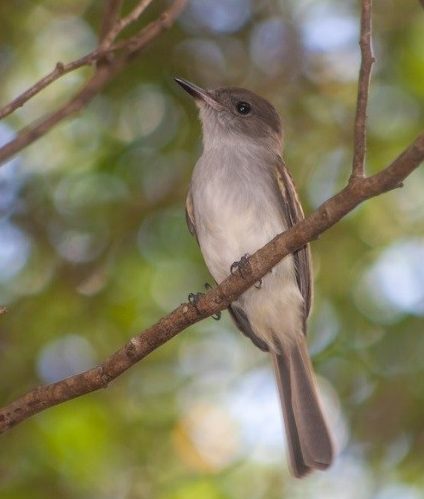
La Sagra’s Flycatcher, M. s. sagrae, showing generally grayish underparts. (Queen Elizabeth II Botanic Park, Grand Cayman; November 17, 2014.) Anonymous eBirder
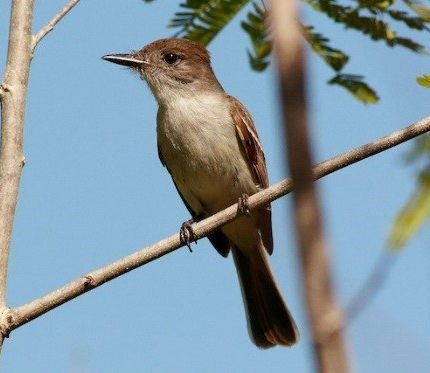
La Sagra’s Flycatcher, M. s. sagrae, showing warm-brown upperparts and whitish belly. (La Turba, Matanzas, Cuba; March 23, 2012.) © Manfred Bienert
Voice. Common call is a sharp, rising WHIT! (or WINK!) that may be given singly, doubly, or many times:Dawn song consists of multiple phrases—most prominently a quiet rolling warble and loud, squeaky, two-note and four-note phrases: WHIP-IT! and WHIP-IT! ZE-WHEEER!
Cf. Ash-throated Flycatcher. Ash-throated and La Sagra’s Flycatchers are similar in appearance and sometimes overlap as strays (especially in Florida, but probably in the West Indies as well). Their typical calls differ, as La Sagra’s’ is a sharp, upslurred whistle, whereas Ash-throated’s is much softer.
When not calling, Ash-throated and La Sagra’s can be distinguished by pattern and coloration.
Underparts: Both species have muted coloration below, but La Sagra’s is paler and more evenly colored—whitish overall, often with a faint yellowish tinge on the belly and vent. Ash-throated typically has a darker, grayish breast and somewhat yellower belly, with a fairly clear demarcation on the lower breast.
Tail: Ash-throated has an extensively rusty tail, especially when spread or when seen from below. The upperside of La Sagra’s’ tail is cold brown, but can show some rufous when spread or when seen from below.
Upperparts: Ash-throated is generally pale brown above, with broad buffy wingbars and other highlights on its wings. La Sagra’s is colder brown, with a more pronounced dark crown and narrow, whitish wingbars and other highlights on its wings. Both have rufous margins on their primaries, but these are broader on Ash-throated.
Notes
Polytypic species consisting of two recognized subspecies: sagrae of Cuba, the Isle of Youth, Grand Cayman, and Great Inagua; and lucaysiensis of the northern Bahamas.
Formerly considered conspecific with Stolid, Puerto Rican, and Lesser Antillean Flycatchers, collectively the Stolid Flycatcher, M. stolidus.
Frontiers of Taxonomy: Divergence and Convergence in the Stolid-La-Sagra’s Flycatcher Complex.
The taxonomic status and relationships of the four subspecies currently grouped under Stolid and La Sagra’s Flycatchers present a conundrum. When Lanyon analyzed their measurements, coloration, vocalizations, response to tape playback, he found that the Jamaican stolidus and Hispaniolan dominicensis were nearly identical, and that the Cuban sagrae and Bahamian lucaysiensis were only slightly more distinguishable from one another. This was the original basis for recognizing La Sagra’s Flycatcher as a separate species.
However, Joseph et al.’s 2004 study of mitochondrial DNA reached a potentially conflicting result. In essence, they found that the Jamaican stolidus (Stolid) and Cuban sagrae (La Sagra’s) are more closely related to one another by ancestry than either is to dominicensis or lucaysiensis. Conversely, they found that the Hispaniolan dominicensis (Stolid) and Bahamian lucaysiensis (La Sagra’s) are also one another’s closest ancestral relatives.
Assuming that the genetic evidence is accurate (i.e., not somehow a fluke of the individuals sampled or the analytical methods used), this situation seems to suggest some form of coevolution. In simplified terms, it suggests that a split occurred between two lineages (representing sagrae/stolidus and lucaysiensis/dominicensis), and that later each of these lineages diverged internally, but somehow each of the resulting four lineages “converged” with a less-related lineage—assembling the current Stolid and La Sagra’s Flycatcher species.
Although this hypothesis may seem peculiar, there may be a biogeographical mechanism that would enable it. Lucaysiensis is found on smaller islands than the others, and is prone to wandering (e.g., regularly straying to southern Florida), while the other three subspecies appear to be mostly sedentary. Perhaps, then, regular strays of lucaysiensis into the range of sagrae resulted in new gene flow between these forms, introducing traits of lucaysiensis into sagrae. This would allow these subspecies to share features, rapidly spread through sexual selection, while the underlying drift in mitochrondrial DNA in the respective populations proceeded on its gradual, inexorable pace.
The argument for continuing to recognize Stolid and La Sagra’s Flycatchers as currently configured is that, as far as has been documented, stolidus and dominicensis are essentially indistinguishable in the field, as are sagrae and lucaysiensis. Functionally, these appear to be the two species definitions that the birds themselves would likely recognize, so the current taxonomic consensus makes sense, even if it contradicts the underlying phylogenetic relationships.
References
Alderfer, J., and J.L. Dunn. 2014. National Geographic Complete Birds of North America (Second Edition). National Geographic Society, Washington, D.C.
eBird. 2019. eBird: An online database of bird distribution and abundance. Cornell Lab of Ornithology, Ithaca, N.Y. http://www.ebird.org. (Accessed February 7, 2019.)
Garrido, O.H, and A. Kirkconnell. 2000. Field Guide to the Birds of Cuba. Cornell University Press, Ithaca, N.Y.
Howell, S.N.G., I. Lewington, and W. Russell. 2014. Rare Birds of North America. Princeton University Press, Princeton, N.J.
Joseph, L. 2019. La Sagra’s Flycatcher (Myiarchus sagrae). In Handbook of the Birds of the World Alive (J. del Hoyo, A. Elliott, J. Sargatal, D.A. Christie, and E. de Juana, eds.). Lynx Edicions, Barcelona. https://www.hbw.com/node/57513. (Accessed February 7, 2019.)
Joseph, L., T. Wilke, E. Bermingham, D. Alpers, and R. Ricklefs. 2004. Towards a phylogenetic framework for the evolution of shakes, rattles, and rolls in Myiarchus tyrant-flycatchers (Aves: Passeriformes: Tyrannidae). Molecular Phylogenetics and Evolution 31:139-152.
Lanyon, W.E. 1967. Revision and probable evolution of the Myiarchus flycatchers of the West Indies. Bulletin of the American Museum of Natural History 136:329-370.
Raffaele, H., J. Wiley, O. Garrido, A. Keith, and J. Raffaele. 1998. A Guide to the Birds of the West Indies. Princeton University Press, Princeton, N.J.
